This summer explore the best places in the Costa Brava with our detailed guide.
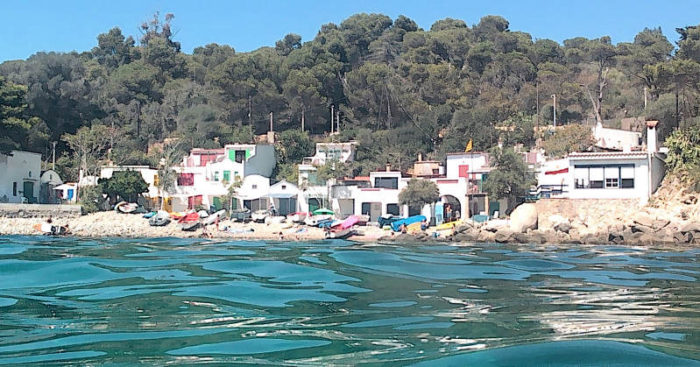
Cala s’Alguer is so close to Platja Castell you can swim. Photo David Leigh.
The Costa Brava, with its rugged coastline, hidden coves, and charming villages, is a treasure trove for any traveller. Stretching from the town of Blanes to the French border, this picturesque region in Catalonia offers a delightful mix of natural beauty, historical landmarks, and vibrant culture. Whether you’re an adventurer seeking new thrills or a culture enthusiast looking to soak up some local history, the region has something for everyone. In this guide, we’ll take you through the best places in the Costa Brava, ensuring your visit is nothing short of spectacular.
Historic villages and towns
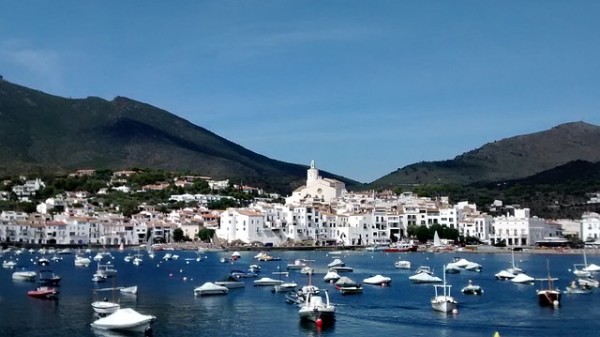
The iconic town of Cadaqués
Cadaqués
Nestled between rugged hills and the sparkling Mediterranean Sea, Cadaqués is often described as one of the most beautiful villages in the Costa Brava. This picturesque town, with its whitewashed buildings and narrow, winding streets, has long been a haven for artists and writers. Salvador Dalí, one of the most famous residents, found inspiration here, and you can visit his former home, now the Salvador Dalí House-Museum. The town’s artistic heritage is palpable as you wander through its charming streets and along its serene coastline.
Pals
Perched on a hilltop, Pals is a medieval village that seems frozen in time. The cobblestone streets, ancient stone houses, and the imposing Romanesque tower create an atmosphere that transports visitors back to the Middle Ages. Walking through Pals, you’ll discover quaint shops selling local crafts, delightful restaurants offering Catalan cuisine, and stunning viewpoints overlooking the lush countryside and – in the distance from some vantage points – the sea. The village’s rich history is evident at every turn, making it a must-visit for history buffs.
Tossa de Mar
Tossa de Mar is a gem of the Costa Brava, renowned for its well-preserved medieval old town, Vila Vella. Enclosed by ancient walls and towers, Vila Vella offers a glimpse into the past with its labyrinth of narrow streets, charming squares, and historical landmarks. The views from the top of the town’s castle are breathtaking, providing panoramic vistas of the turquoise waters and the rugged coastline. Tossa de Mar seamlessly blends history with natural beauty, making it an ideal destination for those who appreciate both.
Begur
Begur is another historic town that captures the essence of the Costa Brava’s rich heritage. Dominated by the ruins of a medieval castle, Begur’s old town is a maze of narrow streets lined with beautifully preserved houses. Many of these homes reflect the town’s history of wealthy emigrants who returned from Cuba in the 19th century, adding an eclectic architectural flair. The town’s charm extends to its stunning coastline, where secluded coves and beaches await exploration.
Peratallada
Peratallada is a quintessential medieval village, renowned for its exceptional state of preservation. The town’s name, which means “carved stone,” reflects its unique construction from solid rock. Visitors can explore a labyrinth of cobbled streets, ancient walls, and a magnificent castle. The Plaza de Les Voltes, with its arcaded passages, is particularly picturesque. Peratallada’s historical ambiance makes it a perfect stop for those looking to step back in time.
Stunning beaches and coves
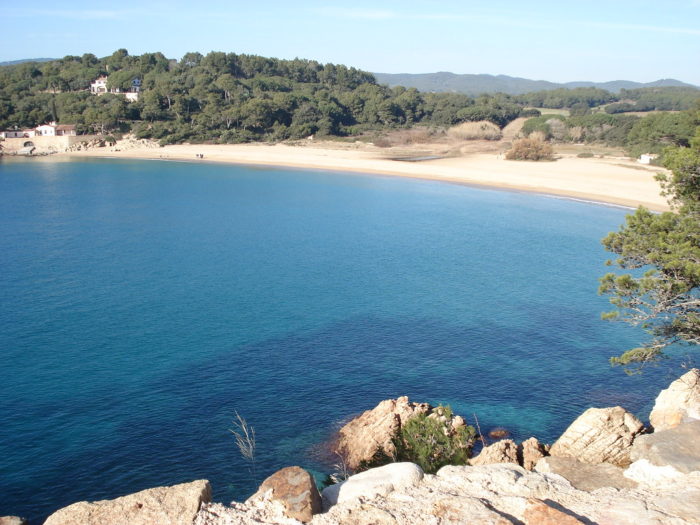
Platja Castell is one of the Costa Brava’s most pristine beaches. Photo by David Leigh
Platja Castell
Nestled in a pristine natural setting, Platja Castell is one of the last undeveloped beaches on the Costa Brava. Known for its crystal-clear waters and fine golden sand, this beach is perfect for those seeking tranquillity and unspoiled beauty. Surrounded by pine forests and protected from overdevelopment, Platja Castell offers a glimpse into the region’s natural heritage. Visitors can explore ancient Iberian ruins nearby or take a scenic hike along the coastal paths, making it a perfect spot for both relaxation and adventure.
Riells
Riells Beach in L’Escala is a family-friendly beach known for its wide sandy stretch and shallow waters, making it ideal for children. The beach is well-equipped with facilities such as showers, sunbeds, and playgrounds. The lively promenade behind the beach is lined with shops, cafes, and restaurants, providing plenty of options for refreshments and meals. Riells Beach offers a vibrant yet relaxing atmosphere, perfect for a day out with the family.
Empúries
The beaches at Empúries, located near the ancient Greco-Roman ruins, offer a unique blend of history and natural beauty. These beaches are known for their clear waters and tranquil environment. Visitors can explore the archaeological site before relaxing on the sandy shores. The surrounding pine forests add to the scenic beauty, providing shaded areas for picnics. The beaches at Empúries are ideal for those looking to combine a cultural experience with beach relaxation.
Estartit
Estartit’s beach, with its long stretch of fine sand and shallow waters, is perfect for families and water sports enthusiasts. The beach offers stunning views of the Medes Islands, a protected marine reserve popular for diving and snorkelling. Estartit Beach is well-served with amenities, including sunbed rentals, beach bars, and water sports facilities. The nearby town of Estartit offers a range of dining and shopping options, making it a convenient and enjoyable destination.
Sant Pol/S’Agaró
Platja Sant Pol is a picturesque crescent-shaped beach known for its golden sands and clear, calm waters. The beach is bordered by elegant beachfront villas and a scenic promenade, perfect for leisurely strolls. The shallow waters make it ideal for swimming and families with young children. S’Agaró offers an upscale holiday experience, with several high-quality restaurants nearby, providing a delightful spot for a meal or drink with a view.
Cala Aiguablava
Cala Aiguablava is known for its striking turquoise waters and soft sandy shore. Located near Begur, this small beach is surrounded by lush greenery and rocky cliffs, creating a stunning natural backdrop. It’s a popular spot for swimming and snorkelling, thanks to the calm, shallow waters. The beach is well-served with amenities, including a beach bar and rental services for water sports. Cala Aiguablava’s idyllic setting makes it a perfect choice for families and nature lovers.
Cala Montjoi
Cala Montjoi is a hidden gem located within the Cap de Creus Natural Park. This secluded cove is famous for its pristine waters and rugged beauty. It was also the home of the world-renowned El Bulli restaurant, which has now become a culinary research centre. Cala Montjoi’s remote location makes it a perfect spot for those looking to escape the crowds and enjoy nature in its purest form. Snorkelling and diving are popular activities here, thanks to the rich marine life.
Sa Tuna
Sa Tuna, a small bay near the town of Begur, is another must-visit beach in the Costa Brava. This pebble beach, framed by traditional fishermen’s houses, offers a unique and picturesque setting. The calm, clear waters are perfect for swimming and kayaking. The surrounding area also features several hiking trails that provide stunning coastal views. Sa Tuna’s charm lies in its tranquillity and scenic beauty, making it a favourite among locals and visitors alike.
Llafranc
Llafranc is a picturesque coastal village known for its charming beach and crystal-clear waters. Surrounded by pine-covered hills, the beach offers a tranquil escape with stunning views of the Mediterranean. Llafranc’s seafront promenade is lined with quaint restaurants and cafes, providing the perfect setting for a leisurely meal with a view. This beach is ideal for those seeking a more serene and scenic beach experience.
Natural parks and hiking routes

The distinctive rock formations of Cap de Creus. Photo by David Leigh
Cap de Creus Natural Park
Cap de Creus Natural Park is a stunning natural reserve located at the easternmost point of the Iberian Peninsula. This park is known for its dramatic landscapes, featuring rugged cliffs, hidden coves, and unique rock formations sculpted by the wind and sea. The park offers a variety of hiking trails that cater to different skill levels, providing hikers with breath-taking views of the Mediterranean Sea and the opportunity to explore the diverse flora and fauna. One of the most popular routes is the trail leading to the Cap de Creus lighthouse, which offers panoramic vistas of the surrounding coastline.
Aiguamolls de l’Empordà
Aiguamolls de l’Empordà is a wetland area that serves as a haven for birdwatchers and nature enthusiasts. This natural park is home to a rich variety of bird species, especially during the migration seasons. The park features several walking and cycling paths that allow visitors to explore its diverse ecosystems, including marshes, lagoons, and meadows. Birdwatching huts are strategically placed throughout the park, providing excellent opportunities to observe birds in their natural habitat. Aiguamolls de l’Empordà is an ideal destination for those looking to experience the serene beauty of the Costa Brava’s natural landscapes.
Montgrí, Medes Islands and Baix Ter Natural Park
This natural park encompasses a diverse range of landscapes, from the mountainous terrain of Montgrí to the marine environments of the Medes Islands. The park offers numerous hiking trails, including routes that lead to the Montgrí Castle, a medieval fortress that provides stunning views of the surrounding area. The Medes Islands, located just off the coast of L’Estartit, are renowned for their rich marine biodiversity, making them a popular spot for diving and snorkelling. The park also includes the Baix Ter wetlands, which are perfect for birdwatching and exploring the natural beauty of the Costa Brava.
Albera Natural Park
Albera Natural Park is situated along the eastern Pyrenees and is known for its unique blend of Mediterranean and alpine ecosystems. The park is home to a variety of flora and fauna, including endangered species such as the Hermann’s tortoise. Hiking trails in Albera Natural Park offer visitors the chance to explore ancient cork oak forests, picturesque vineyards, and historic ruins. The park also features several megalithic monuments, including dolmens and menhirs, which provide a fascinating glimpse into the region’s prehistoric past. Albera Natural Park is a must-visit for nature lovers and history enthusiasts alike.
Gavarres Massif
The Gavarres Massif is a mountainous area covered with dense forests of cork oak and holm oak. This natural park offers a network of well-marked hiking and cycling trails that wind through its scenic landscapes. One of the highlights is the path to Sant Miquel castle, which offers panoramic views of the surrounding countryside. The Gavarres Massif is also home to several charming villages, such as Monells and Madremanya, where visitors can experience traditional Catalan architecture and hospitality. The park’s rich biodiversity and tranquil environment make it a perfect destination for outdoor enthusiasts.
Cultural attractions
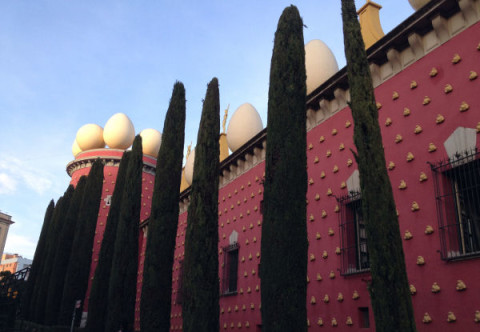
The Dalí museum in Figueres. Photo by David Leigh.
Salvador Dalí attractions
The Costa Brava is deeply intertwined with the life and work of the surrealist artist Salvador Dalí. The region boasts several attractions dedicated to his legacy, each offering a unique glimpse into his eccentric world.
Dalí Theatre-Museum, Figueres
The Dalí Theatre-Museum in Figueres is one of the most important and intriguing attractions in the Costa Brava. Designed by Dalí himself, this museum is as much a work of art as the pieces it houses. The building, with its distinctive red façade and egg-topped towers, invites visitors into a surreal journey through Dalí’s mind. Inside, you’ll find a comprehensive collection of his works, ranging from his early creations to his later, more experimental pieces. The museum also features the crypt where Dalí is buried, making it a place of pilgrimage for art enthusiasts from around the world.
Casa-Museu Salvador Dalí, Portlligat
Located in the picturesque village of Portlligat, the Casa-Museu Salvador Dalí was Dalí’s primary residence for much of his life. This labyrinthine house, made up of a series of fishermen’s huts, is filled with eclectic decorations and personal items that reflect Dalí’s unique lifestyle. The house offers stunning views of the Portlligat Bay, and its interior provides an intimate look at the everyday life of the artist. Visitors can explore Dalí’s studio, living quarters, and the beautiful gardens where he found much of his inspiration.
Gala Dalí Castle, Púbol
The Gala Dalí Castle in Púbol is a testament to the artist’s devotion to his wife and muse, Gala. Dalí bought and restored this medieval castle for her, and it now serves as a museum dedicated to their relationship. The castle is filled with art and personal items that tell the story of their life together. The gardens, featuring sculptures of elephants with long legs and other surreal elements, reflect Dalí’s artistic vision. The castle also includes Gala’s crypt, adding to its significance as a site of both artistic and personal importance.
Local festivals and events
The Costa Brava is renowned for its vibrant cultural scene, with numerous festivals and events that celebrate its rich heritage and lively spirit.
Carnival of Roses
The Carnival of Roses is one of the most anticipated events in the Costa Brava, drawing visitors with its colourful parades, elaborate costumes, and lively music. Held in February, this carnival transforms the town into a festive spectacle, with floats, dance performances, and a variety of street entertainment. It’s a family-friendly event that showcases the joyous and celebratory spirit of the region.
Habaneras Festival, Calella de Palafrugell
The Habaneras Festival in Calella de Palafrugell is a unique cultural event that pays homage to the region’s seafaring history. Held every July, this festival features traditional habaneras music, which originated from the Cuban habanera dance. The festival takes place on the beach, creating a magical atmosphere as the sounds of guitars and singers fill the air. Visitors can enjoy local seafood, drinks, and join in the sing-alongs that often accompany the performances.
Festival Castell de Peralada
The Festival Castell de Peralada is a prestigious summer music festival held in the beautiful gardens of the Peralada Castle. This festival features a diverse programme of opera, classical music, ballet, and contemporary performances, attracting renowned artists from around the world. The stunning setting and high-calibre performances make it a highlight of the Costa Brava’s cultural calendar.
Cap Roig Festival
The Cap Roig Festival, held in the stunning botanical gardens of Cap Roig, near Calella de Palafrugell, is another major cultural event. This summer festival offers a diverse line-up of music, from pop and rock to classical and jazz. The venue, with its breathtaking views of the Mediterranean Sea, provides a perfect backdrop for world-class performances, making it a must-visit for music lovers.
Porta Ferrada Festival
The Porta Ferrada Festival is one of the oldest music festivals in the Costa Brava, held in the charming coastal town of Sant Feliu de Guíxols. Celebrated since 1958, this festival takes place during the summer months and offers a diverse programme that includes music, theatre, and dance. The festival’s open-air performances are set against the backdrop of the town’s historic architecture, creating a unique and atmospheric experience. With artists ranging from local talent to international stars, the Porta Ferrada Festival is a highlight of the Costa Brava’s cultural calendar and a must-visit for those seeking high-quality entertainment in a picturesque setting.
Embrace the magic of the Costa Brava
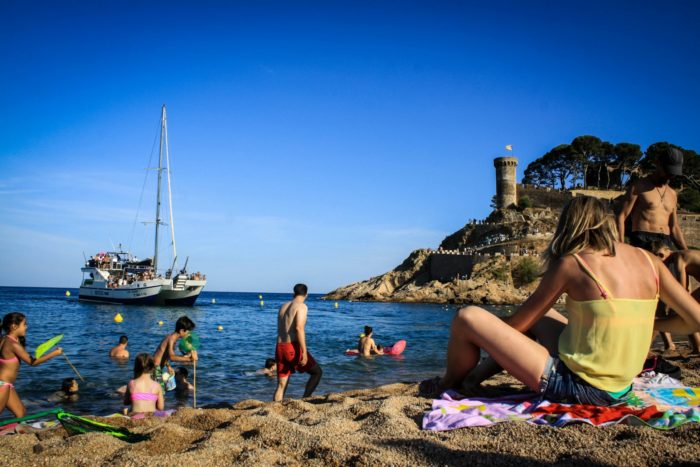
Tossa de Mar’s main beach: Photo by Andrea Huls Pareja.
All in all, the Costa Brava is a treasure trove of beautiful landscapes, historic towns, and vibrant cultural attractions. From the surreal world of Salvador Dalí to the lively local festivals, there is something for everyone to enjoy. This guide has highlighted some of the best places to visit, but the true magic of the Costa Brava lies in its ability to surprise and enchant at every turn. Whether you’re drawn to the pristine beaches, the rugged natural parks, or the charming medieval villages, the Costa Brava invites you to explore and discover your own personal favourites. So pack your bags, hit the road, and experience the unforgettable charm of the Costa Brava.

